Driving the tranquil byways of the Karoo, Anton Crone avoids the overcrowded Garden Route and pays homage to a great protagonist of roadtripping in this two-part tale from Cape Town, ending eventually in Durban.
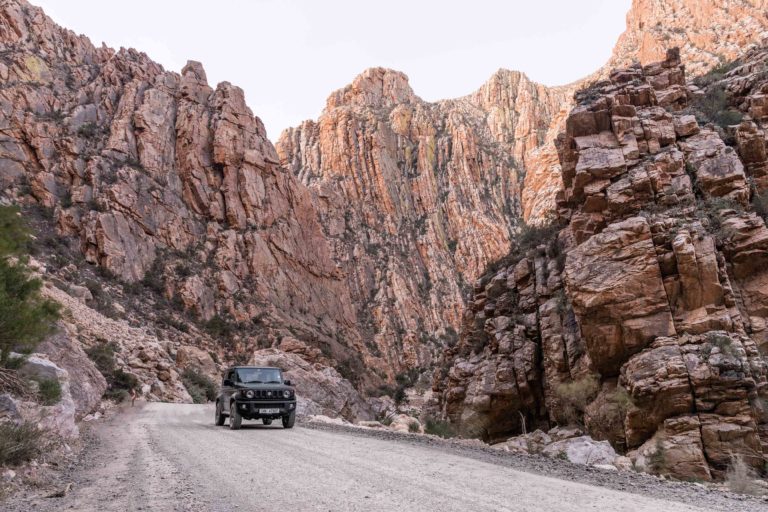
Image: Anton Crone.
During most school holidays, my wife Sarah and I remain in Cape Town. We clock up speeding fines on roads usually crammed with shrines to the drive-time DJ; we zoom over desolate school crossings; we double-park because we can. The city becomes our bubble of joy. That bubble was pierced by a belated invitation to Pietermaritzburg for Easter. Our families felt unloved by their Cape Town progeny. Guiltily, we accepted, then gawped at the impossibility of flights. On a map, I sketched a route around the holiday bedlam of the Garden Route with a Standard 8 vintage koki pen. Through the Klein Karoo and southern Drakensberg, winding passes became slivers of yellow; I cut felt-tip swathes through pastures where the most common words spoken are ‘moo’. And then one morning off we went at dawn…

Consecrated in 1865, the NG Gemeente Church remains the focal point of Prince Albert. Image: Anton Crone.
Leaving the N2 holiday traffic behind, we entered the quiet valley of Elgin where my koki had marked a route to that old fruit of a town, Montagu, on Route 62. Along the way, sheep bleated in surprise at the sight of us, children free of scholastic shackles took time out from their soccer game to wave hello; farm workers grinned at us as they trimmed peach trees. The sun was high as we drove through the little rock tunnel before Montagu – a time portal for me. You enter a world of silent wonders here, ancient mountains folded in on one another like an immense dried apricot. Beyond Montagu some holidaymakers, having tired of the congested N2, trickled into Barrydale via Tradouw Pass. ‘Tradouw’ is derived from the Khoi words tarras meaning path, and doas meaning woman – Woman’s Path. Built in the 1860s by Thomas Bain, it is indeed an homage to femininity with gentle curves winding through a lush valley. We would encounter more of this famous road-engineer’s masterpieces further along our route.
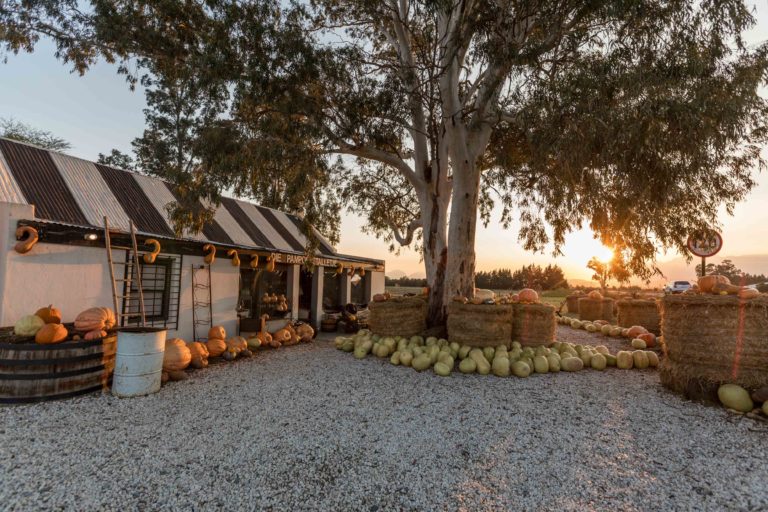
The fruits of Die Pampoenstalletjie near Robertson herald the rich colours of the Cape Fold Mountains. Image: Anton Crone.
I drove on, clutching a mammoth chilli-and-chocolate shake from Barrydale’s faux 50s gas station, Diesel & Crème. By the time we hit 100 kilometres per hour my mouth was on fire. As another chunk of chilli shot up the straw I tried, between coughs, to convince Sarah that it was delicious and that the ancient Aztecs had gotten their kicks this way. Through the tears, I struggled to take in the landscape and slowed to a more sedate pace. We didn’t speed up again for the next 1,500 kilometres. What for? It was just too beautiful. Ahead of us, the Klein Swartberg slowly emerged. It was humbling, coursing through the little mountains of the Little Karoo in our little car, a newly acquired Suzuki Jimny which we intended to set free on grittier terrain than the current blacktop. Past Ladismith we skirted the Groot Swartberg, the road coiling along the mountain fringe until it corkscrewed into the Gamkarivier Valley, giving sustenance to the wines of Calitzdorp.
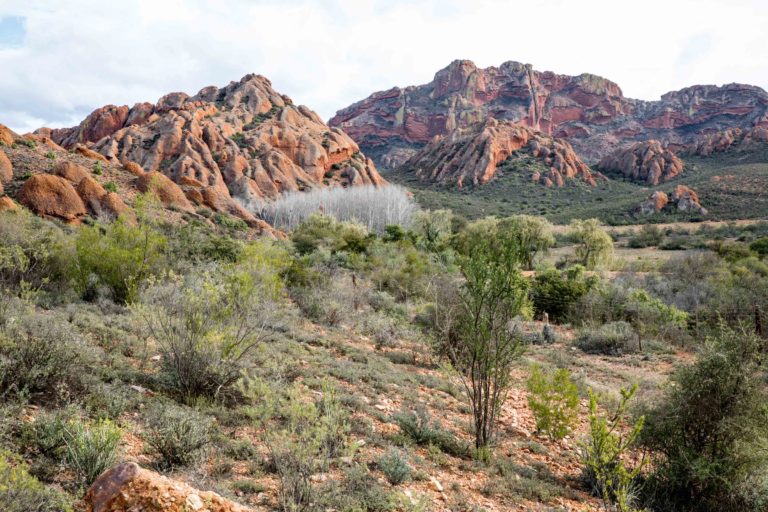
The red colour of the hills near Oudtshoorn is due to iron-rich conglomerates deposited in the Cretaceous Period, 130 million years ago. Image: Anton Crone.
A few kilometres further, we left the tarmac and introduced the Jimny to its first taste of dirt. Winding along the Kruisrivier Valley, red hills rose like theatre curtains on either side, threaded by wind and water to form arches and caves. Rich red soil gave life to green pastures and vines along the valley floor, which narrowed to a point as it reached the imposing Swartberg massif. Bain’s opus, the Swartberg Pass, winds 24 kilometres over this extraordinary range. The rocky route can appear daunting at first but it’s navigable in a regular car and we were thrilled to see an old VW Beetle making its way to the summit. If the views climbing out of the Klein Karoo were breathtaking, the descent into the Great Karoo required oxygen tanks. In truth, you don’t descend – you sink into the Swartberg like a giddy stone, deep into the bowels of a tumbling ocean of rock. At the bottom, you look back in an attempt to fathom it all. You’ve just passed through millions of years of history, back to a time when Australia was a part of this landmass, when ‘Packing for Perth’ wouldn’t have been such a schlep. After travelling this route, we wondered why anyone would want to emigrate.

The winding Swartberg Pass affords a view over the ruined gaol where hundreds of prisoners were incarcerated while constructing the road. Image: Anton Crone.
But some folks have had a different relationship with the Swartberg. By the time Bain completed this, his last creation, in 1888, it had taken a huge toll on the convicts who toiled on its slopes using fire and cold water to crack enormous rocks; hand tools and aching muscles to carve this road. The remains of a jail stand on the northern side of the pass. According to Lawrence Green’s 1955 book, Karoo, more than 150 convicts died here. On the way out of the pass towards the gentrified village of Prince Albert, we stopped for the umpteenth time to gaze in awe. A movement among the rocks revealed a pair of klipspringers. Frozen in the knowledge that we had discovered them, their dark eyes assessed us, then they took off, prancing along the cliff face until they vanished. De Rust, a smaller and slightly less refined village, is linked to Prince Albert by nearby Meiringspoort. One of Bain’s earlier creations, here he followed the natural course of the Grootrivier creating an elegant road that crosses the river 25 times in 25 kilometres with the rhythm of a tango. The low drifts are liable to flood in heavy rains and this originally prompted the creation of Swartberg Pass as an alternative route. Like dizygotic twins, sister and brother, refined and rustic, they are scions of an engineering master who made Cape roadtripping such a delight.
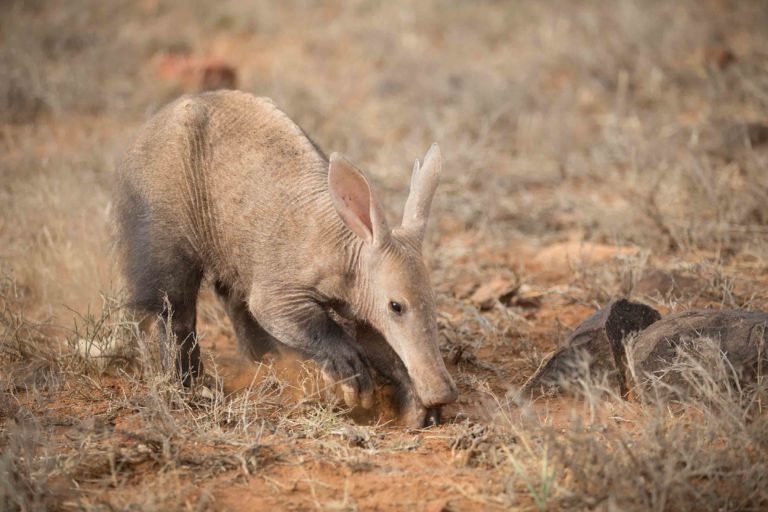
Widespread throughout Africa, aardvarks are rarely seen during daylight hours, but these ant-eating engineers of deep burrows make special winter appearances at Samara. Image: Anton Crone.
Steering north-east into the Karoo proper, we encountered endless plains that would have bored a road engineer like Bain. Or perhaps this flatland gave him perspective, an escape from the labyrinth of switchbacks, hairpin bends and unassailable cliffs. Bain’s last venture was to assess irrigation sites on the Orange River. Trekking 1 600 kilometres by ox cart through the vast, often featureless interior, his health faltered and he never recovered. When he began working on our roads, there were only three engineered passes in the entire country – one of which, Bain’s Kloof, was built by his father. By the time he died, Thomas Bain had built 26. Without his mastery, we would have no escape from holiday traffic. Bain would have encountered all manner of creatures on his last venture, many of which have long since become locally extinct. As we crossed the Plains of Camdeboo we stopped at Samara, a game reserve that is reintroducing megafauna such as elephant, giraffe, lion and cheetah. For me, the most remarkable resident is, however, the aardvark.

Mountain zebras favour dry, stony, mountainous habitats so are quite at home in their namesake park near Cradock. Image: Anton Crone.
Our penchant for gawking at wild animals piqued, it was towards Mountain Zebra National Park that we steered, reaching the foothills at Buffelshoek Pass. This route, not being a scion of Bain, is hard going for regular cars but our new Jimny relished the challenge. As we climbed, a pair of Verreaux’s eagles soared along the escarpment wall and we stopped to trace their flight. Looking back, we realised we’d had a tremendous run so far, unencumbered by traffic, delayed only by spectacular sights. There were no queues at the entrance to Mountain Zebra National Park: an immense plain and a band of rugged mountain ranges stood between us and the school-holiday madness to the south.
Slow route to Cradock
Cape Town to Kruisrivier Head out on the N2; after Sir Lowry’s Pass turn onto the R321 at Grabouw, cross Theewaterskloof Dam and on to the R43. Then take the R60 to Robertson, the R62 to Montagu and on to Calitzdorp via Barrydale. After Calitzdorp turn left onto the gravel road to Kruisrivier (Red Stone Hills Farm is 6,5km further on – see ‘Stay Here’ opposite).
Kruisrivier to Prince Albert (via Die Hel) From Kruisrivier head east to the R328, via Matjiesrivier, and onto Swartberg Pass. For the scenic 37km detour to Die Hel, turn left to Gamkaskloof just after the summit – 4×4 is recommended. Retrace your journey and descend the pass on the R328 to Prince Albert.
Prince Albert to Samara Go east on the R407 and drive through Meiringspoort (N12) to De Rust. Take the R341 and N9 to Willowmore. Just before Graaff-Reinet, turn right onto the R63 – the entrance to Samara is 36km on.
Samara to Cradock Continue on the R63 to Pearston, follow the R337 gravel road to Cradock and take the N10, then R61 to MZNP.
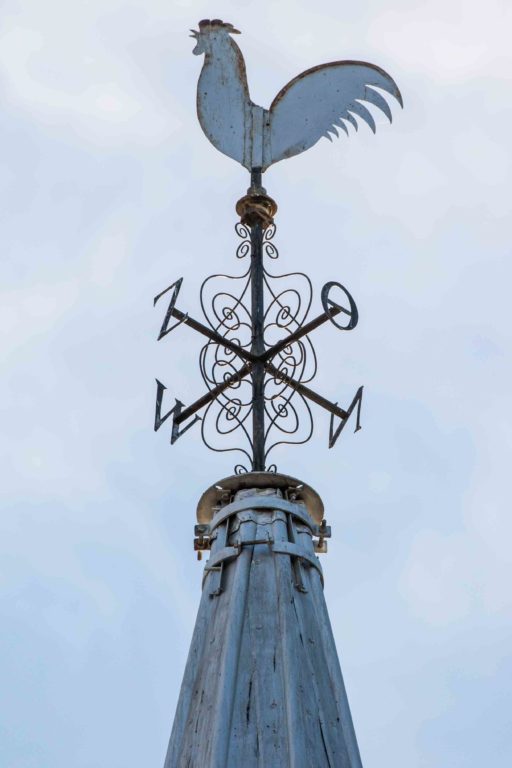
Which direction should we travel next? Or maybe we’ll just stay – what says the spire of Prince Albert’s NG Gemeente Church? Image: Anton Crone.
Plan your trip
Stay here
Red Stone Hills Farm is an ideal base to explore the beautiful landscape of the Kruisrivier Valley – eight secluded self-catering cottages are spread among the red hills. From R360 pp sharing. 0729015654, redstone.co.za
Haven on Church is a guest house in an old Karoo building in the heart of Prince Albert. Host Elsabe Koen offers great advice on local activities and her breakfasts are scrumptious. There’s a vintage room in the old house and a garden room out back. The quaint, next-door cottage has just been bought and will provide more accommodation (opening in December). R400 pp sharing B&B. 0826357309, havenonchurch.co.za

Haven on Church guest house. Image: Anton Crone.
Housemartin Guest Lodge in De Rust is a classic Victorian house with 12 double rooms leading onto beautiful gardens. It offers self-catering or bed & breakfast, and dinner on request. From R495 pp sharing. 0827868491, [email protected]
Die Hel is a recommended 4×4 cul-de-sac detour off the Swartberg Pass. There’s rustic self-catering accommodation in 11 of the original settlement houses, from two-sleepers at R500 to an eight-sleeper from R880. You can even stay in the old bus shelter (sleeps 12). Power is gas or solar. Camping is R150 per night. 0870878250, capenature.co.za
Karoo Lodge, the beautifully restored homestead at Samara Private Game Reserve, gives visitors a real sense of old Karoo living. From R3,100 pp sharing for all meals and two safari activities daily. 0312620324. samara.co.za
Mountain Zebra National Park has cottages from R656 pp sharing, family cottages, a large guest house and Mountain Cottage accessed by 4×4 (sleeps 10) from R979. The 20 campsites are from R323 per night. Daily conservation fees are R55 for adults, R28 for kids. 0124289111, sanparks.org
Do this
Horse ride or hike through the striking red hills of Kruisrivier, or drive the 8km 4×4 trail. Contact Red Stone Hills Farm. 072-901-5654, redstone.co.za
Swim in the beautiful deep pool under the 60-metre waterfall in Meiringspoort.
Explore Cango Caves, just 15km from the south end of Swartberg Pass. 0442727410, cango-caves.co.za
Hike the five-day Swartberg Trail or a variety of shorter routes with accommodation at overnight huts. Permits, maps and information from CapeNature. 087-087-8250, capenature.co.za
Eat Here
Diesel & Crème in Barrydale is an ideal first stop from Cape Town. The over-the-top 50s-style decor revives the feel of a classic road trip. Save space for a takeaway milkshake from the caravan at the back. 0285721008
The Victoria Dining Room in Prince Albert’s Swartberg Hotel is one of the few hotel restaurants that hasn’t forsaken its old-world charm. Delicious meals include many Karoo classics. 0235411332
Victoria Manor in Cradock also holds on to its yesteryear feel. The hotel’s history reaches deep beneath the ballroom floorboards, but that’s a story for next month’s issue… 0488811322, tuishuise.co.za
About the Car
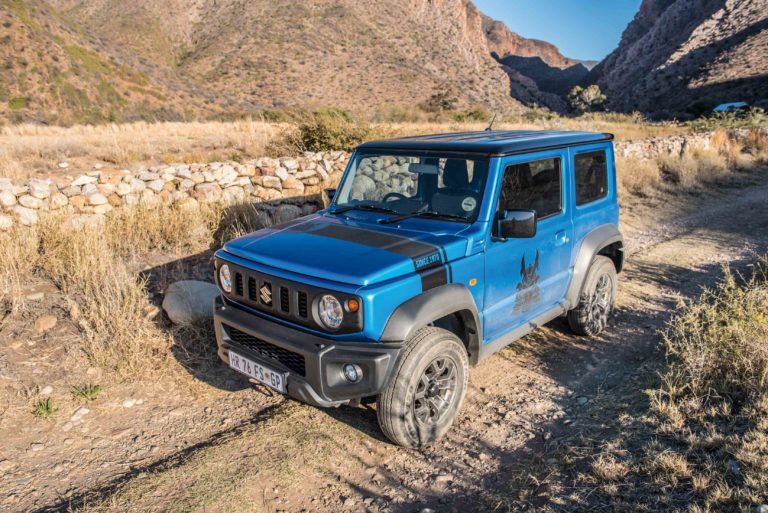
Image: Justin Fox
This is one sexy little 4×4. The new Suzuki Jimny is small and light, meaning it can go places other 4x4s can’t, gliding over mud, sand and up slippery slopes where larger vehicles tend to make heavy weather. It was able to climb over substantial obstacles without scraping the bumpers or underbody, thanks to ample approach and departure angles, and good ground clearance. The new 1,5L engine delivers high fuel efficiency and generates decent torque over a wide rpm range for great off-road performance. From R274,900. suzukiauto.co.za
You may also like
Related Posts
Whether you’re in a two-person hiking tent eye-balling the peaks or a full caravan in...
read more
There’s an old saying that reads, 'You just have to keep driving down the road....
read more
Catherine Hofmeyr shares what's new (and what's still hot) on a coastal self-drive holiday from...
read more